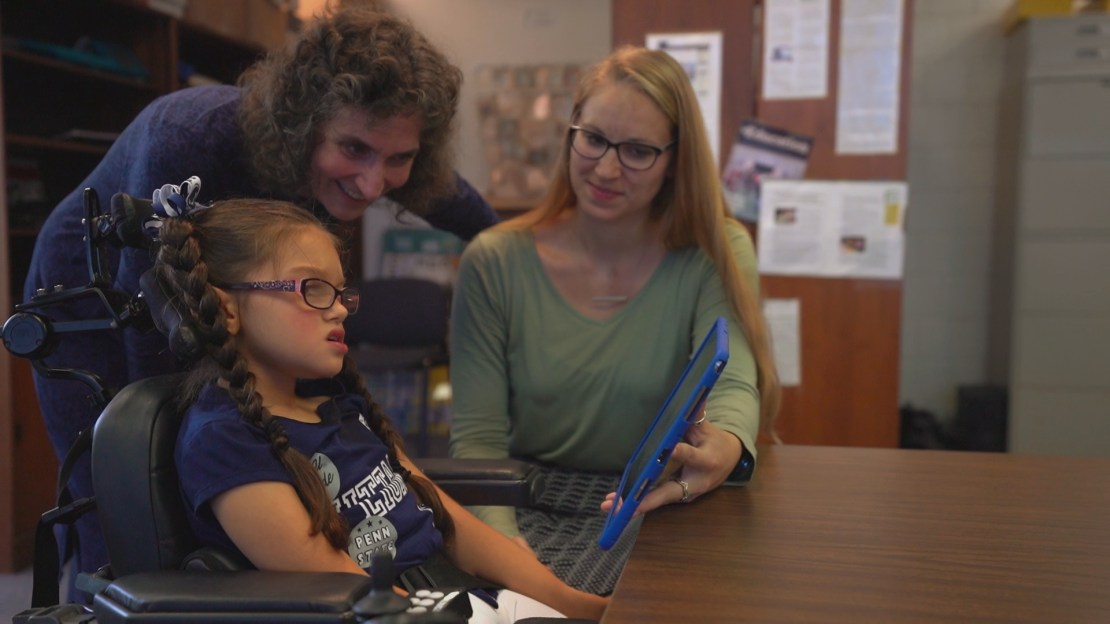John Tolley, September 27, 2019
When Olivia Peters wants to communicate with her parents, her teacher, her friends, she doesn?t use her voice, but she does get her point across.
Olivia has pontocerebellar hypoplasia (PCH,) a genetic condition affecting the formation and function of muscles in her body, including those needed to speak. This often leads to a lack of communication development in those with PCH, but, thanks to her Tobii eye-gaze device and the work of the Augmentative and Alternative Communication (AAC) Center at Penn State, Olivia is speaking up, so to speak.
?The program has helped her tremendously [and] has broadened her vocabulary immensely,? says her mother, Karina Peters. ?It?s shown her different ways to communicate with us. It?s given her confidence, so she?s able to really speak her mind [and] tell us what she wants.?
The program is the brainchild of Janice Light, the Hintz Family Endowed Chair in Children?s Communicative Competence. She has dedicated her career to finding new and innovative ways to provide means to communicate for those without the ability to communicate with the world around them. This includes children who are born with complex disabilities and adults with acquired conditions that limit or their ability to speak.
?Communication is everything for us,? says Light. ?It really is how we establish who we are, how we?re able to connect with the world. Speech and language and typing and writing, those are things that come so easily to all of us. Sometimes we forget how incredibly important those things are.?
Light?s journey started while still a college student. Volunteering in a preschool for children with special needs, Light noted that though many of the students lacked the ability to communicate conventionally, they still possessed keen and eager minds. But a lack of knowledge in how to connect with these children meant that they often fell behind their peers in terms of educational exposure.
After further work with both adults and children with limited communication, and seeing the deleterious effect on their lives, Light decided it was time to make a change. ?It was that moment that I decided we need to make a difference here. We need to find ways for these individuals to communicate.?
When Light was starting out, the field of AAC was still in its infancy. This put her in an advantageous position at the forefront of research seeking both new ways to establish communication and new technologies to best assist communication.
The AAC Center at Penn State is funded federally by the National Institute on Disability, Independent Living and Rehabilitation Research. Their mission is fourfold, she explains.
First, is the research component centered on advancing our understanding of communication disorders and improving outcomes for individuals with complex disabilities. Second, they work in technological development to improve communication devices and solutions for these individuals. Third is a training component including a very active doctoral program that is establishing the next generation of leaders in the field. Finally, is their global outreach that supports the translation of research to practice.
Over the years, Light has seen an explosive growth in the field with an abundance of research now available, technology that has moved from simple paper to complex computerized systems, and communication devices that allow for much greater access. She adds that annually between 80 and 100 thousand people use the AAC Research Center?s websites and training programs.
What hasn?t changed, says Light, is the human element. ?The thread that drives all of this is the people. So, I try and make sure that they are vibrant within the teaching that we do [and] a constant presence in everything that we do. I?m a huge believer in science, but science is driven by the unmet needs within society. It?s the people that bring those stories that drive our science.?







